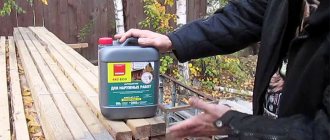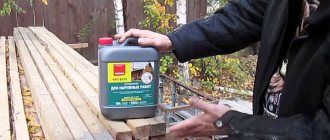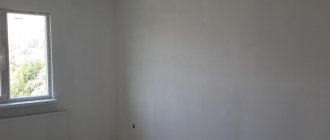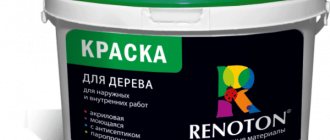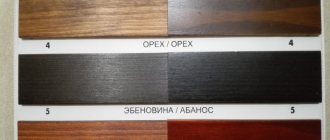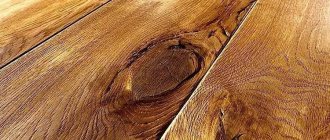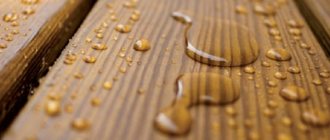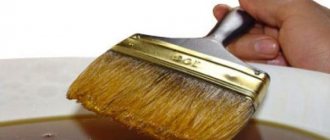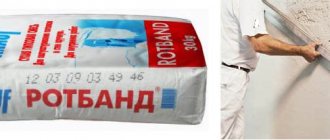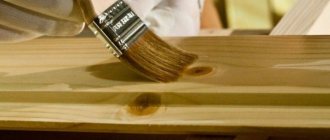Wood as a material will never lose its relevance. But to maintain its beauty and durability, the surface must be periodically subjected to protective treatment.
In outdoor conditions, impregnation for outdoor use is used for this purpose. Thanks to it, the tree becomes resistant to bad weather, insects, and fire.
The main thing is to choose the impregnation that suits your design and is suitable for its purpose.
Why impregnate wood?
The material is popular in construction due to the following advantages:
- environmental friendliness;
- hygroscopicity;
- heat capacity;
- sound insulation;
- aesthetics (even without additional finishing);
- ease of processing and installation;
- affordable price.
However, a wooden structure that is constantly located on the street is destroyed over time under the influence of:
- ultraviolet rays;
- high humidity;
- fungus, mold;
- insects, bark beetles;
- precipitation;
- dust, dirt;
- sudden changes in temperature;
- damage;
- fire.
To prevent spoilage, an impregnation was developed.
It is needed to extend the service life of the material by forming a protective layer on the surface or penetrating deep into the structure.
The drugs are produced in a narrowly targeted manner, when some resist moisture, others – fungus (antiseptics), others – fire (fire retardants), there are decorative ones and more. Complex action impregnations are also available. They are more expensive, but more effective.
It is recommended to work with the product at a temperature of +10 degrees. It will absorb evenly and dry quickly.
In addition, impregnation can be an excellent base for painting. The paint applies well, giving the wood the desired color.
Which wood stain is better: photos of colors and palettes of different compositions
Stain allows you to refresh an old interior and transform the appearance of your home, both inside and outside. There is no need to buy new furniture or replace doors and windows. It is enough to apply a decorative coating to a previously prepared wood surface.
When choosing a high-quality stain, you can be sure that it will protect the wood from excess moisture and negative external influences
Stain, unlike paint, forms a transparent layer on the surface. It penetrates deep into the wood, giving the material the necessary shade, which can vary from walnut to mahogany and mahogany. If you look at a surface treated with a tinting composition, the color result can easily be confused with a natural color. You may get the impression that the tree is in its original form.
What you need to know about wood species when choosing impregnation
Depending on the type, trees have different degrees of resistance to biodestruction:
- The weakest. This includes linden, alder, and aspen.
- Weak resistance. Solid elm, maple, birch and beech sapwood.
- Medium resistant. These include fir, larch, and spruce.
- Sustainable. Ash, pine, solid oak.
Based on absorbency, rocks are divided into 3 categories:
- Difficult to impregnate. Ash, solid oak and beech, spruce.
- Average. Linden, alder, aspen, solid pine.
- Lungs. Beech, birch, pine sapwood.
It is important to note that when choosing raw materials for construction outside, the key factor remains the resistance of the rock to destruction, so you need to choose the most resistant ones.
Alcohol stain
It is sold in the same way as water, in two versions: dry and liquid. The powder is diluted with ethyl alcohol, due to which the treated surface dries quickly, which is ideal for outdoor work. When working internally, the room must have excellent ventilation so that the unpleasant smell of wood stain disappears.
It is recommended to apply alcohol stain with a spray gun, since the applied layer dries quickly, and in this case a perfect even application cannot be achieved with a brush.
Classification of impregnations for external use by purpose
According to this parameter, funds are divided into several types. Let's look at the features of each of them in more detail.
Anti-darkening
A change in the color coating of raw materials is caused by infection with a fungus. This most often happens when wood is stored outdoors for a long time or in constant contact with the ground.
It is important to understand that budget protective impregnations have a limited service life - from 3 to 6 months. More expensive formulations continue to operate after 1–2 years.
The drug must be difficult to wash out or cannot be washed out with water. A striking example is the domestic impregnation brand “Senezh”.
Material already infected with fungus must first be bleached, that is, the cause of infection - fungus or mold - must be eliminated.
For treatment in outdoor conditions, it is allowed to use products containing chlorine. But a significant disadvantage of such compositions is that the impregnation not only burns out harmful microorganisms, but also destroys the wood structure.
Preparations with active oxygen have proven to be much more effective. They destroy fungus without harming the material and do not emit harmful substances.
From moisture and rotting
These are solutions with water-repellent properties. Penetrate deep into the structure. Prevents deformation and rotting of raw materials under the influence of moisture.
Their advantage is that after applying the composition the wood continues to breathe.
The service life of the protective layer is 1-3 years. After its expiration, it is recommended to recoat the material.
High quality impregnation will prevent the material from cracking as it dries. This is especially necessary on the end parts of log houses.
In addition, look for the presence of ultraviolet filters in the composition. Their absence will lead to a reduction in the effect of the product, and the treated surface will begin to darken.
For load-bearing structures
These include:
- rafter systems;
- beams, partitions;
- ceilings;
- walls;
- base;
- basements.
Photo: treatment of the rafter system with a spray bottle.
To reliably protect such elements, the preparation must have the following properties:
- antiseptic;
- fungicidal;
- do not wash off with water;
- increase fire resistance.
They are often colorless, water-based liquids.
The disadvantage of inexpensive impregnations is that they paint the surface a greenish tint. Expensive preparations do not change the shade of wood.
When using indoors, it is important to pay attention to the composition so that it does not contain toxic substances.
Decorative
Compared to others, the purpose of these stains is to add beauty to structures and products. With their help, it will be possible to perform high-quality imitation of noble breeds.
Most acrylic-based products are environmentally friendly. They make the surface elastic, waterproof, add shine, protect the surface from ultraviolet rays, and at the same time act as an antiseptic. They have a wide range of colors.
Frost-resistant
It is recommended to purchase for external wood processing in the northern regions of the country. Withstands air temperatures down to –40 degrees.
Can be applied in the cold without loss of working properties. They tolerate repeated freezing and thawing normally.
Sun protection
They also act as antiseptics. They contain a filter against ultraviolet rays, which serves as reliable protection for the tree. Bright colors do not fade in the sun or fade over time. The surface does not crack due to temperature changes.
Article: how to build a pergola from wood
Fire retardants
This is the name given to the preparations that make the raw material highly flammable. Prevents combustion in case of fire.
The most effective products are those that combine fire and bioprotection. Penetrate deeply into the structure or form a film. They may change the color of the coating, but not the texture of the wood.
When purchasing fire retardants, check for quality certificates and fire safety reports.
Characteristic properties
Wood stain is a unique and multifunctional material. When used, a specific film is formed on the surface of products, providing protection from the adverse effects of humidity, mold and microorganisms. As a result, these products can last longer.
With the help of stain, you can emphasize the texture or radically change the color of the wood, showing the versatility of your imagination and creativity. Using different colors of wood stain, you can easily give any surface the desired color.
Famous manufacturers
Below is a list of manufacturing companies whose products are in greatest demand.
Belinka
Country of origin: Slovenia.
Engaged in the production of impregnations for the protection and decoration of wood. This:
- transparent antiseptics;
- penetrating primers;
- azure multilayer impregnation with the addition of wax;
- azure decorative impregnations;
- paints.
Belinka has official representative offices throughout Russia.
Aquatex
A Russian company that produces several types of combined impregnation compositions:
- “Aquatex Extra” - based on wax, oil;
- “Aquatex primer antiseptic” is a non-washable antiseptic;
- "Aquatex" - decorative with bioprotection and others.
Each contains an ultraviolet filter.
Aquatex does not produce products with biopyrene protection.
Tikkurila
The Finnish concern produces many series of paint and varnish products. Products with antiseptic protection, against insects, ultraviolet radiation. They have an environmentally friendly composition. Some antiseptics can be tinted.
Senezh
Russian trademark.
Specialization - production of impregnations for processing wood and decking boards.
The list of products includes:
- biopyrenes;
- preservative solutions;
- antiseptics;
- decorative;
- protective compounds.
There are tinted solutions. The price is affordable.
NEOMID
Russian manufacturing company.
The products are considered one of the best on our market for protecting wood and decking boards from fire and moisture.
On average, antiseptic protection lasts 10 years, and against fire – 7 years.
To control the quality of processing, a tinting pigment is included.
Can be used in residential buildings, bathhouses, gazebos, summer kitchens.
Oil stain
Linseed oil is the main component of oil stain. Before use, the product is usually diluted with white spirit, resulting in the coloring of wooden surfaces in different shades.
Its advantages include: ease of application (with a brush), sufficient penetration depth, protection from moisture. However, oil stain takes a long time to dry.
Tips for choosing
When purchasing, we recommend paying attention to the following points:
- Purpose and place of use. Indoors, it is worth taking environmentally friendly water-based formulations with natural oils. They are produced in the form of a concentrate. There are no special restrictions for outdoor work.
- Availability of quality certificates. Without them, the likelihood of purchasing an effective product is minimal.
- Determine the reason for processing. There are narrowly targeted impregnations on sale that protect only from moisture, insects or fire. The optimal purchase would be a complex drug that combines several properties at once.
- If you want your product to look beautiful, take time to choose the color. Check to see if the product can be tinted.
- Take the drug with a reserve, since concentrates from different batches may differ in tone.
- You should not buy impregnation in the markets. The conditions for storing and transporting goods there are practically not observed. There is a high risk of purchasing a fake.
- Study the instructions for use, namely the service life of the coating. Most products retain their properties for no more than 3-5 years. Inflated figures are a marketing ploy.
- Don't forget about application methods. There are impregnations that are used only by soaking the wood.
- Don't forget to wear a respirator while working.
For outdoor use, it is recommended to use universal, complex action products that simultaneously resist bad weather, insects and fire.
Waxing technology
To perform the work, the following tools are required - sandpaper with different grain sizes, a construction knife, a hard brush, a brush, and also a soft cloth. If wood is being processed for the first time, then the wax material can be easily distributed on the surface being processed and is perfectly fixed to it. Before applying a wax or a mixture of oils to a previously painted surface, preparatory work is carried out.
Cleansing stage
The wood should be thoroughly cleaned from the old coating layer:
- Start with solvent treatment. The layer of paint or varnish material will be saturated with organic liquid. After this, the residue can be removed easily and quickly.
- Leave the treated boards for a while to allow the solvent to evaporate.
- The wood should be wiped with water at room temperature, and then dried as best as possible.
- Poorly removed paint residues should be removed with a knife. The surface should be cleaned with sandpaper. Paint can be removed from cracks with a brush.
So now you have smooth wood that is ready for the waxing process. You can also watch a useful video on the topic.
Application stage
Only a dry product can be treated with wax.
- Spread the mixture with a soft cloth, moving from the central part to the edges, corners, and even curly elements.
- The composition, which has a liquid consistency, should be applied with a brush.
Please note that your hand will move in the direction of the grain. Otherwise, the material will not fit and adhere well to the surface being treated. Soon the coating will begin to peel off.
- Leave the coating to dry when all the wood has been processed. In a warm and dry room, the layer will dry out after just an hour.
- By lightly touching an area hidden from view, you can check the degree of drying.
- Excess wax-type material (it is poorly absorbed even after the overall surface dries) can be removed with a cloth. These areas can be wiped with light movements.
Further application of a layer of wax or oil mixture makes the decorative surfaces even more beautiful. At the very end, the surface should be polished.
Polishing
A special device with an electric drive is used here. Connected to a rotating shaft with an electric drill, it will quickly polish treated wood. In order to preserve the natural appearance of the wood as much as possible, it is covered with a waxy transparent material. You can impregnate oak with linseed oil. Wood tinting can be done with a colored compound. You should also take into account the type of wood, as well as the owners’ desire to obtain specific shades of its surface. For example, black and brown impregnations should be applied to dark oak. Wax of the same color is applied to red wood.
Varieties
You can cover absolutely any wood surface with stains - pine, oak, maple, birch and so on. But you still need to know the types of this product, because each type of stain has certain properties.
Water
The presence of water in the composition of the stain is considered the main constituent ingredient. The group of water-based impregnations is considered the largest. Typically, these products are prepared in finished form or in powder form. The powder can be diluted in water independently according to the attached instructions.
Positive traits:
- Due to the fact that this product has a neutral base, it does not have increased toxicity and does not have any harmful effects on health;
- Availability of a wide range of shades with natural texture. Using these types of products, you can create shades from the lightest to deepest, which will help recreate a natural look and deepen the tone. This quality also gives the surface an expressive and noble appearance;
- It is easy and simple to apply, with minimal product consumption;
- Suitable for any type of wood - pine, birch, oak, maple, walnut, cherry;
- Not high cost.
Alcohol type stain
This product is available in the form of aniline dye, which is dissolved in denatured alcohol. This type of stain is sold both ready-made and dry in powder form, which must be dissolved.
This product has the advantage of drying quickly. However, this quality provides some qualities when manually applying the mixture to wood; after drying, greasy stains often form. Therefore, many builders recommend using a spray gun when using alcohol products.
Oily
In these products, all oil pigments are dissolved in solvents or White Spirit. This composition provides a number of advantages to this type of stain:
- When painting, it provides tinting of wooden surfaces in various colors;
- Oil mixtures are convenient to use at home;
- The composition adheres well to the surface and can be applied with any tools;
- The oil stain evenly enters the area of the wood structure, while forming a protective film on the surface.
Acrylic and wax
Wood stain, which is made from an acrylic or wax base, is new to the construction market. This product has proven itself positively among many consumers and professional builders. This is due to the fact that this mixture, after application, creates high protection for the base from negative influences and premature wear.
Features of the composition:
- After application, this type of impregnation forms an insulating film on the surface of the wood, through which moisture and other negative substances do not penetrate;
- Various color characteristics. Compared to other varieties, this composition has a variety of colors from natural to bright exotic tones;
- These types of stains are used by many modern furniture designers. These products are used to paint the external facades of cabinets, tables, and chairs made of different types of wood.
With whitening effect
It is not always necessary that the wood be dark in color; sometimes it is required that, on the contrary, it have a slightly whitish color. In these cases, impregnations based on hydrogen peroxide and acids are suitable. With their help you can get a light, bleached color of wooden beams. Typically, these solutions are used to prepare the surface for further painting.
Stain is simply a necessary thing to improve the quality of wood. This product protects the base from rapid wear and destruction. The main thing is to choose the right product and carefully read the instructions and characteristics of the composition. But which mixtures to choose all depend on what they will be used for - to improve color or for protection. It is better to first study the properties of each type of stain.
Color variety
The most popular are natural shades of stains, which best harmonize with the wood. For furniture finishing, bog oak and walnut are often chosen. Wenge, mocha, and nutmeg will give wood a browner color. The burgundy palette includes mahogany, maple, and cherry.
You can achieve the desired shade by mixing several types of stains. It is important to maintain proportions and use mixtures from only one manufacturer. For larch and pine, both dark and light walnut options are suitable. This paint is classified according to the international standard. Each color has a name and its own code.
When choosing a mixture, a test coloring of the wood is carried out. The resulting shade will be influenced by the natural color and type of material. The quality and density of solutions is of great importance. Compositions with the same numbers from different manufacturers can produce shades of different saturation and depth.
Features of the material
Stain is produced in liquid form, more often it is a dark-colored composition that can give the wood a translucent tint. With its help you can radically change the appearance of furniture. The liquid penetrates deep into the wood, changing its color without disturbing the texture or pattern. Special varnishes are used in the restoration of all kinds of products, for bleaching and lightening.
The main feature of multifunctional compositions is the absence of a film after drying, revealing a natural pattern. The surface becomes contrasting and juicy. Staining is the most effective way to protect wood from rotting and deformation. When working, you can combine different shades of the mixture for all species - pine, oak, walnut, rosewood.
How to prepare a wooden surface for finishing
The beauty and aesthetics of the finish depends not only on the quality of the stain, but also on the properly prepared surface. It should be smooth, silky, without scratches or other defects. Preparation for staining includes:
- thorough cleaning of wooden objects from dust, dirt, grease stains;
- removal of old paintwork;
- sanding and grinding;
- test coloring.
It is important for the home craftsman to know that sanding is always done along the grain. At the first stage, medium-grain sandpaper No. 120 is used for sanding, and at the second stage, fine sandpaper No. 220 is used. If furniture or other parts are made of coniferous wood, they must be deresined with a special compound. Grease stains are removed with a cloth moistened with alcohol or white spirit. Traces of wood glue are easily washed off with hot water.
When the first three conditions for preparing for staining have been met, it is necessary to do a test staining on a separate piece of board, which will help you choose the right color and its intensity.
Applying stain to a dry, clean and smooth surface is the key to a high-quality, beautiful finish.
Examples of interiors in wenge color
In the dining room and kitchen, it is better to use a classic scheme, according to which dark shades are given a place below head level. In this case, the room will seem more spacious. In addition, dark brown has a relaxing effect, which is not entirely appropriate in the kitchen, where the housewife needs a lively mood for preparing holiday dishes.
Wood tones are not necessarily present in furniture and flooring. Wenge can find a place for itself on the ceiling in the form of a tier of a multi-level ceiling. This solution is quite suitable for high walls. In this case, black wall cabinets are hidden, creating a niche effect, and do not compete with the nobility of the African guest.
What to do if you want dark brown walls? Maintain this shade in the chandelier, chandelier and tabletops. Decorate the walls and floor in creamy tones. Decorative accents of red, burgundy, and green are allowed.
Can wenge make friends with toffee? Yes, if you mix it with golden veins. A dark shade will emphasize the depth of the niche in the kitchen set. And so that he does not feel lonely, we will give him a door, a chandelier and lamps as companions. The chocolate napkins are the icing on this cake.
I really want tsavo, but the kitchen is small. And the hostess likes there to be a lot of light and space. What to do?
The solution is actually very simple. Order a white set with a horizontal contrasting stripe on the fronts of the wall cabinets. If you want even more contrast, use the same shade in the fronts of the lower cabinets. At the same time, white or steel narrow stripes will create movement dynamics. An excellent solution for modernity.
To relieve the feeling of hospital sterility, lay cocoa-and-milk colored tiles on the floor.
Wenge is a great place for creative ideas. At the same time, this color loves to be surrounded by milky and creamy tones interspersed with natural pink, purple, red and yellow shades. Create exquisite interiors that are characterized by luxurious simplicity and VIP class elegance.
